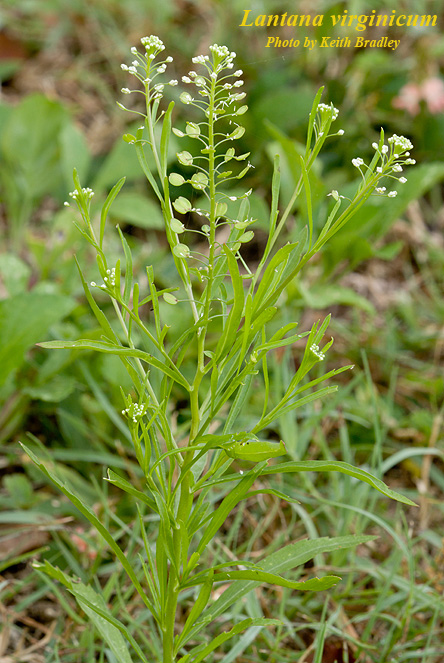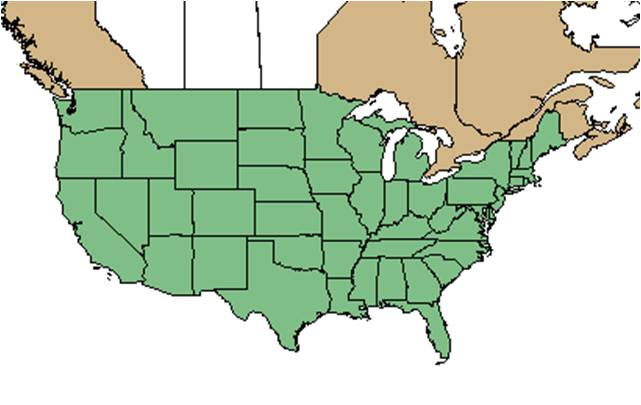Lepidium virginicum
| Lepidium virginicum | |
|---|---|

| |
| Photo by Keith Bradley, Atlas of Florida Vascular Plants | |
| Scientific classification | |
| Kingdom: | Plantae |
| Division: | Magnoliophyta - Flowering plants |
| Class: | Magnoliopsida – Dicotyledons |
| Order: | Capparales |
| Family: | Brassicaceae ⁄ Cruciferae |
| Genus: | virginicum |
| Species: | L. virginicum |
| Binomial name | |
| Lepidium virginicum L. | |

| |
| Natural range of Lepidium virginicum from USDA NRCS Plants Database. | |
Common name: Virginia pepperweed; Poor man's pepper[1]
Contents
Taxonomic notes
Synonyms: none.[1]
Varieties: none.[1]
It is similar to Lepidium campestre in both appearance and growth habitat; however, the lobed rosette leaves and bottle brush appearance of mature L. virginicum can help distinguish the two species.[2]
Description
A description of Lepidium virginicum is provided in The Flora of North America.
L. virginicum is a prolific weed that can either be an annual or biennial species, depending on environmental conditions.[3] Initially, it appears as a low growing rosette with pinnatifid leaves; later, the stems emerge upward, occasionally branching, often becoming bushy. Flowers can be found blooming at the top of the raceme; and at the bottom, flattened seedpods take the place of flowers. It is often said to resemble a bottle-brush.[4][2] The flowers are small and white, with 4 petals and 2 stamens.[3]
Distribution
This species can be found throughout North America, except Prairie Provinces and parts of the far north. [3]
Ecology
Habitat
L. virginicum is usually found in disturbed areas such as roadsides, waste places, vacant lots, sandy fallow fields, and lawns. It has also been found in natural communities such as river floodplains, marshy salt flats bordering mangrove swamps, and sandy flats and shores of shallow lakes.[5] This species has been found growing in highly disturbed areas such as the Copper Basin, which has long been subjected to sulfur dioxide pollution. Here, it has been observed to have an ecotypic adaptation resulting from natural selection in this area.[6]
Soils include loamy sand and sandy loam. Associated species include cyperus and mangroves.[5]
Phenology
Initially, L. virginicum appears as a low growing rosette with pinnatifid leaves, with a stem emerging later, branching occasionally, causing the plant to be bushy.[4] The tiny white flowers have 4 petals and 2 stamens and are found at the top of the raceme, with seeds appearing on the lower end of the raceme, replacing the flowers. It can be observed flowering January through November with peak inflorescence in April and fruiting February through November.[5][7]
Seed dispersal
The individual seedpods may be carried a short distance by the wind or an entire raceme of mature seedpods will become detached from the mother plants and drift away in the wind.[4]
Seed bank and germination
In a study conducted by Toole and Cathey (1961) it shows that when treated with gibberellic acid, seeds can germinate in total darkness and at higher temperatures. Toole and Toole (1955) found that Coumarin promotes germination to at a certain level (1.1*10^-4) and past this level causes inhibition.
Herbivory and toxicology
Lepidium virginicum has been observed at the Archbold Biological Station to host plasterer bees from the family Colletidae such as Colletes mandibularis; sweat bees from the family Halictidae such as Augochlorella gratiosa; leafcutting bees from the family Megachilidae such as Heriades leavitti; thread-waisted wasps from the family Sphecidae such as Ectemnius rufipes ais, Oxybelus laetus fulvipes and Tachysphex similis; wasps from the family Vespidae such as Stenodynerus fundatiformis.[8] Additionally, L. virginicum has been observed to host plant bugs such as Lygus lineolaris and Pseudatomoscelis seriatus.[9]
L. virginicum is commonly used as a food source for the larvae of Pieris butterflies and noctuid moths, aphids, beetles, and grasshoppers. There is an induced response to herbivory such as increasing the number of trichomes per leaf. Pieris rapae caterpillars are not affected by the induced response of herbivory to this species.[10]
Conservation, cultivation, and restoration
L. virginicum can often be thought of as a noxious weed in some crops. Alida et al. (1998) found populations of L. virginicum that are resistant to paraquat applications in southern Ontario.
Cultural use
The seeds are often eaten for their peppery taste.[3] There are health-promoting properties of L. virginicum that have been used in traditional Mexican medicine to treat diarrhea and dysentery.[11]
Photo Gallery
References and notes
Alida, S., D. Colleen, et al. (1998). "Paraquat Resistance in Horseweed (Conyza canadensis) and Virginia Pepperweed (Lepidium virginicum) from Essex County, Ontario." Weed Science 46(2): 200-204.
Toole, E. H., V. K. Toole, et al. (1955). "Photocontrol of Lepidium Seed Germination." Plant Physiology 30(1): 15-21.
Toole, V. K. and H. M. Cathey (1961). "Responses to Gibberellin of Light-Requiring Seeds of Lettuce & Lepidium Virginicum." Plant Physiology 36(5): 663-671.
- ↑ 1.0 1.1 1.2 Weakley, A.S. 2015. Flora of the southern and mid-atlantic states. Working Draft of 21 May 2015. University of North Carolina at Chapel Hill, Chapel Hill, North Carolina.
- ↑ 2.0 2.1 [[1]]Accessed January 9, 2016
- ↑ 3.0 3.1 3.2 3.3 [[2]] Ladybird Johnson Wildflower Center. Accessed: January 8, 2016
- ↑ 4.0 4.1 4.2 [[3]] Illinois wildflowers Accessed: January 11, 2016
- ↑ 5.0 5.1 5.2 Florida State University Robert K. Godfrey Herbarium database. URL: http://herbarium.bio.fsu.edu. Last accessed: October 2015. Collectors: Loran C. Anderson, D.J. Banks, D.E. Breedlove, D. Burch, Andre F. Clewell, K. Craddock Burks, Suellen Folensbee, R.K. Godfrey, Gary R. Knight, Robert M. Laughlin, O. Lakela, Robert J. Lemaire, S.W. Leonard, Marc Minno, Richard Mitchell, Jackie Patman, Elmer C. Prichard, Gwynn W. Ramsey, Peter H. Raven, Cecil R. Slaughter, Victoria I. Sullivan, L.B. Trott, Edwin L. Tyson, Bruce Walton, D.B. Ward, Jean Wooten. States and Counties: Florida: Bay, Brevard, Collier, Dixie, Escambia, Franklin, Gadsden, Hamilton, Hernando, Hillsborough, Holmes, Indian River, Jackson, Jefferson, Leon, Liberty, Marion, Okaloosa, Orange, Polk, St. Johns, Taylor, Union, Volusia, Wakulla, Walton. Countries: Mexico, Panama. Compiled by Tall Timbers Research Station and Land Conservancy.
- ↑ Murdy, W. H. (1979). "Effect of SO2 on Sexual Reproduction in Lepidium virginicum L. Originating from Regions with Different SO2 Concentrations." Botanical Gazette 140(3): 299-303.
- ↑ Nelson, G. PanFlora: Plant data for the eastern United States with emphasis on the Southeastern Coastal Plains, Florida, and the Florida Panhandle. www.gilnelson.com/PanFlora/ Accessed: 12 DEC 2016
- ↑ Deyrup, M.A. and N.D. 2015. Database of observations of Hymenoptera visitations to flowers of plants on Archbold Biological Station, Florida, USA.
- ↑ Discoverlife.org [4]
- ↑ Agrawal, A. A. (2000). "Benefits and Costs of Induced Plant Defense for Lepidium virginicum (Brassicaceae)." Ecology 81(7): 1804-1813.
- ↑ Osuna, L., P. Tapia, et al. (2006). "Micropropagation of Lepidium virginicum (Brassicaceae), a Plant with Antiprotozoal Activity." In Vitro Cellular & Developmental Biology. Plant 42(6): 596-600.